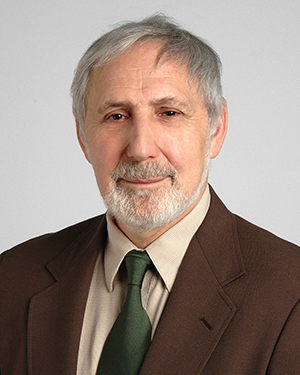George Stark Laboratory
-
George Stark Laboratory
- Principal Investigator
- Research
- Our Team
- Publications
- Careers
- Research News
Research
Our cells are instructed on how to behave by a large number of external signals, which come from contact with neighboring cells, from signaling molecules that enter the circulation from elsewhere in the body to affect distant cells, and from signaling molecules that alert us to the presence of invading organisms (viruses, bacteria, fungi, parasites). The signals are conveyed from the outside of the cell to the inside by specialized receptors on the cell surface. Responses to signals result in changes in cellular functions, for example, by increasing the level of antiviral proteins in response to an infection. These changes are carried out by increasing the amounts of specific proteins or by changing their properties. We study the details of these complex interactions in innate immunity and in cancer.
Biography
Education & Professional Highlights
Research
Insertional mutagenesis: We use a lentiviral vector to insert a strong promoter in or near genes in human cells, generating populations of millions of cells, each of which can over-express a different specific protein. We then enrich the population for cells with a specific phenotype of interest, for example, resistance to a drug. Sequencing the RNAs that are linked to vector sequences gives us candidate genes whose products may mediate the phenotype. This methodology has very broad applications. We have used it identify novel methylations of STAT3 that modulate function and to identify mechanisms of resistance to ionizing radiation. We also collaborate enthusiastically with other labs who wish to use this method.
Responses to interferon (IFN): The response to type I IFNs is modulated by a growing number of secondary mechanisms, some of which have profound effects on the roles of IFN in tumorigenesis and resistance to infections. Tyrosine phosphorylation of STAT1 and STAT2 are vital fo the primary transcriptional response to IFN, but we now know that phosphorylation of two threonine residues of STAT2 have major regulatory effects. Furthermore, without tyrosine phosphorylation, STAT2 has important roles in driving gene expression, including genes whose products mediate drug resistance in cancer.
Interferon synthesis in cancer: Cancer cells make endogenous Type I IFN in response to internal signals, especially dsRNA produced from endogenous retroviral elements in the DNA and cytoplasmic DNA, produced in response to intrinsic DNA damage, which activates the cGAS/STING pathway, leading to IFN synthesis. In response to endogenous IFN, cancer cells upregulate resistance to DNA damaging agents.
Cell-intrinsic roles of PD-L1: A new interest in the lab concerns the ability of PD-L1 to modulate how cells respond to IFN-1. This aspect is separate from the well-studied PD-1/PD-L1 interaction.
Novel therapies: We are studying the new drug CBL0137 in lung cancer and are collaborating with other labs to evaluate it in preclinical models of rectal cancer and in combination with other modalities, including cis-platin and ionizing radiation. We are also studying the anti-osteoporosis drug bazadoxifene, which inhibits STAT3 activation, as a potential therapeutic agent in GBM.
Our Team
Selected Publications
IRF9 and unphosphorylated STAT2 cooperate with NF-κB to drive IL6 expression.Nan J, Wang Y, Yang J, Stark GR.Proc Natl Acad Sci U S A. 2018 Apr 10;115(15):3906-3911. doi: 10.1073/pnas.1714102115. PMID: 29581268
The FACT inhibitor CBL0137 Synergizes with Cisplatin in Small-Cell Lung Cancer by Increasing NOTCH1Expression and Targeting Tumor-Initiating Cells.De S, Lindner DJ, Coleman CJ, Wildey G, Dowlati A, Stark GR.Cancer Res. 2018 May 1;78(9):2396-2406. doi: 10.1158/0008-5472.CAN-17-1920. PMID: 29440145
Responses to Cytokines and Interferons that Depend upon JAKs and STATs.Stark GR, Cheon H, Wang Y.Cold Spring Harb Perspect Biol. 2018 Jan 2;10(1). pii: a028555. doi: 10.1101/cshperspect.a028555. Review.PMID: 28620095
Negative regulation of type I IFN signaling by phosphorylation of STAT2 on T387.Wang Y, Nan J, Willard B, Wang X, Yang J, Stark GR. EMBO J. 2017 Jan 17;36(2):202-212. doi: 10.15252/embj.201694834. PMID: 27852626
IFNβ-dependent increases in STAT1, STAT2, and IRF9 mediate resistance to viruses and DNA damage.Cheon H, Holvey-Bates EG, Schoggins JW, Forster S, Hertzog P, Imanaka N, Rice CM, Jackson MW, Junk DJ, Stark GR.EMBO J. 2013 Oct 16;32(20):2751-63. doi: 10.1038/emboj.2013.203. PMID:24065129
Careers
Training at Lerner Research Institute
Our education and training programs offer hands-on experience at one of the nationʼs top hospitals. Travel, publish in high impact journals and collaborate with investigators to solve real-world biomedical research questions.
Learn MoreResearch News

The topical ointment uses the small molecule PALA, first developed to treat cancer 50 years ago.

The former chair of the Lerner Research Institute, George Stark, PhD, was celebrated with a day-long cancer symposium with talks from collaborators and colleagues on July 7.

A new program funded by a National Cancer Institute grant aims to advance treatments that target the mechanisms tumors use to grow and survive.


